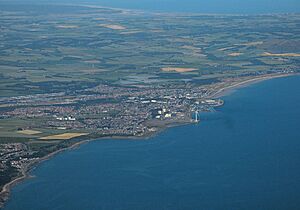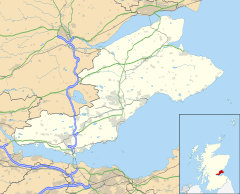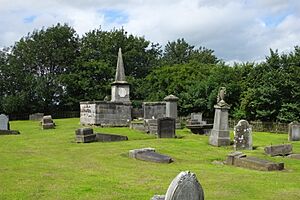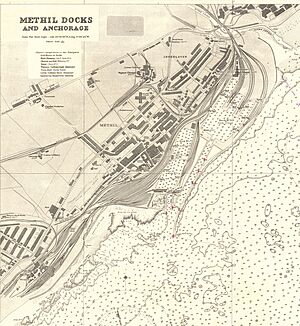Methil facts for kids
Quick facts for kids Methil
|
|
|---|---|
 East Wemyss, Buckhaven, Methil and Leven from the air |
|
| Area | 4.79 km2 (1.85 sq mi) |
| Population | 10,890 (2020) |
| • Density | 2,273/km2 (5,890/sq mi) |
| OS grid reference | NT365995 |
| • Edinburgh | 17 mi (27 km) |
| • London | 344 mi (554 km) |
| Council area | |
| Country | Scotland |
| Sovereign state | United Kingdom |
| Post town | Leven |
| Postcode district | KY8 |
| Dialling code | 01333 |
| Police | Fife |
| Fire | Fife |
| Ambulance | Scottish |
| EU Parliament | Scotland |
| UK Parliament |
|
| Scottish Parliament |
|
Methil (Scottish Gaelic: Meadhchill) is a town on the eastern coast of Scotland. It was first mentioned as "Methkil" in the year 1207. At that time, it belonged to the Bishop of St Andrews. People have lived here for a very long time. Two ancient burial sites from the Bronze Age show that the area is over 8,000 years old.
Methil was once part of its own special area called a barony in 1614. It was also part of the larger town area known as Buckhaven and Methil. This larger area was officially a "burgh" (a type of town with its own government) from 1891 to 1975. Today, Methil is part of a bigger urban area called Levenmouth.
Methil is located between Largo Bay to the east and Wemyss Bay to the west. It used to be a very important industrial town, especially for shipping coal. It was once Scotland's biggest coal port. Now, Methil is looking towards a future powered by green energy. The River Leven separates Methil from the towns next to it.
Contents
What Does the Name Methil Mean?
The name "Methil" comes from Scottish Gaelic. It seems to mean 'middle church'. This is because meadh(on) means 'middle' and cill means 'church'.
The town first grew around a medieval church near the River Leven. In the 1600s, it became a port and a burgh (a town with special rights). It was also known as "Methilltoune" in 1670 and "Methilburgh" in 1795. Sometimes, it was called "Innerleven." An old map from William Roy calls it "Methill Pans," which refers to the salt-making industry there. Today, some local people still call the town "The Methil."
A Look at Methil's History
Methil was once its own church parish before a big change called the Reformation. Later, it became part of the Parish of Wemyss. In the 1600s, it grew into a coastal village with a natural harbor. In the early 1900s, Methil grew much bigger because of a boom in coal mining.
From 1920 onwards, many new homes were built, mostly council houses. This caused the town to spread inland. It eventually connected with the village of Methilhill. It also reached the Methilmill Cemetery, where the old parish church used to be.
Methil's Main Industries
Historically, coal mining was the main industry in Methil. Most of the coal was sent out through Methil Docks. Between World War I and World War II, the docks shipped over 3 million tons of coal each year.
A related development was the Methil Power Station, built in 1960. It was located at the mouth of the River Leven. This power station used coal slurry, which was a waste product from mining. The power station was taken down in 2011.
Sports and Education in Methil
Near Methil is the new Bayview Stadium. This is the home ground for East Fife Football Club. Their old stadium was in the center of town.
Kirkland High School and Community College used to be a secondary school here. In August 2016, it joined with Buckhaven High School to form Levenmouth Academy. Both of the older school buildings were then taken down. Primary schools in the area include Denbeath Primary, Aberhill Primary, and Methilhill Primary. Aberhill Primary is considered important for its architecture and history.
Methil Docks and Future Plans
Methil Docks were very important during World War II. They helped move coal and other supplies. The docks had a special power station that used water to power the coal hoists. These hoists were once famous local sights.
Several railway lines ran through Methil, connecting the coal mines to the docks. One of these lines crossed the High Street on a bridge. Even after the railways and coal mines became government-owned, they stayed connected.
There are plans to reopen the railway line from Thornton Junction. This would help trade and improve public transport. It could also boost tourism for the whole area. The railway is expected to open in spring 2024.
The "Hydrogen Office" is based in the docks. Its goal is to show how much better energy efficiency can be. It also explores the benefits of renewable energy and hydrogen power systems.
Local Government
Fife Council manages local politics in Methil. However, some people are interested in having more local councils again. Methilhill had a Community Council for a while, but it is not active right now.
A group of Fife councillors represents the area that Fife Council calls "Levenmouth." This area includes Methil and other nearby towns. The name "Levenmouth" helps with local government work.
Images for kids
See also
 In Spanish: Methil para niños
In Spanish: Methil para niños





